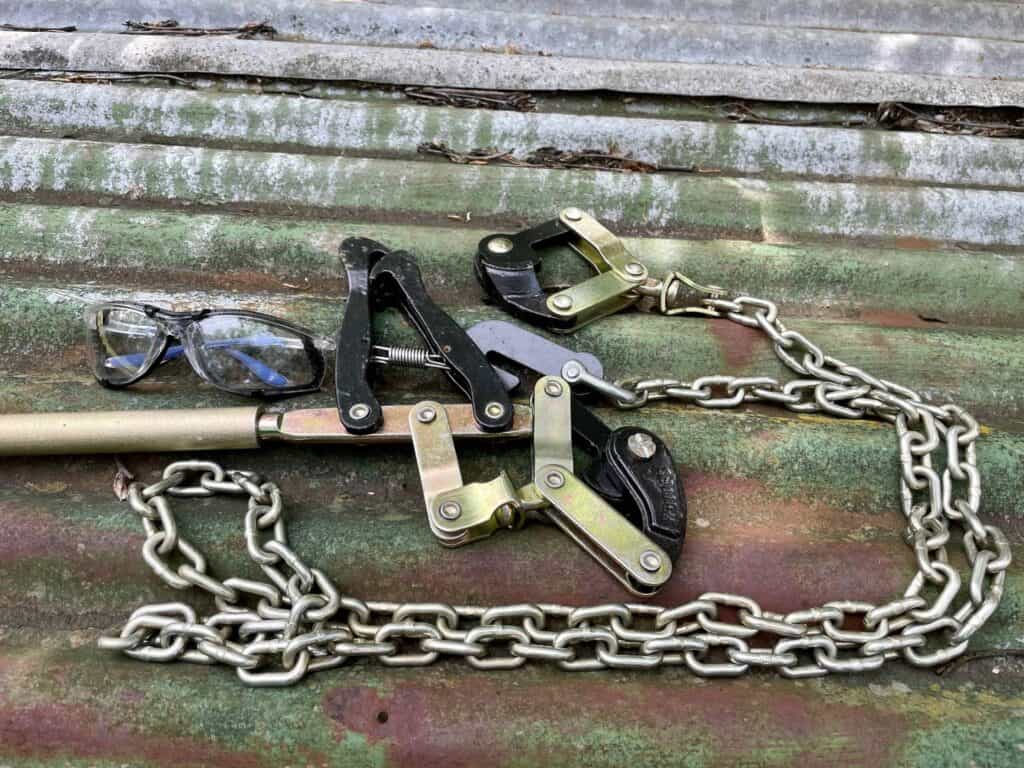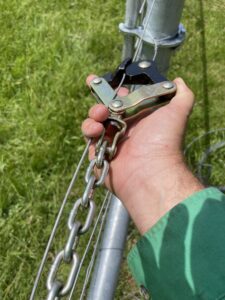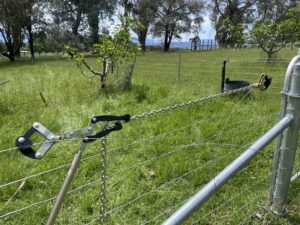Mastering Fence Strainers: A Beginner’s Guide

Watch the Video Here
Mastering fence strainers is a crucial skill for any landowner. Whether you’re securing your property or keeping livestock in check, properly strained fences are essential. In this beginner’s guide, we’ll explore the fundamentals of using a basic set of strainers and provide you with tips to make the process easier, safer, and more effective. Check out my new basic fencing course HERE

Tip #1: Prioritize Safety Before we dive into the intricacies of fence straining, let’s emphasize safety. Safety glasses should be a non-negotiable part of your gear. When working with wire and tension, accidents can happen, and eye protection is your first line of defense. Leather gloves are essential when working with Barbed Wire. Now let’s start mastering fence strainers

Lay Out Your Strainers: Start by laying out your strainers on the ground before you begin using them. This simple step ensures they’re within easy reach when your hands are occupied with wire. It’s a small action that can make a big difference in the efficiency of your work.

Begin at the Bottom of End Posts: When you start straining your fence wires, always begin at the bottom of your end posts, not the top. Even the most well-constructed end posts can shift slightly, so it’s best to secure your wires lower down for stability. However, if your fence run is 50 meters or longer, you can strain directly to the end post. For shorter runs you may need to strain the wire in the run and secure with a fencing knot. This video explains how.
Chain Orientation: If you are straining your wire to the end post, wrap your chain about 15 centimeters above the point where you plan to tie off the wire. Ensure that the hook is on your side of the fence, with the chain on the opposite side. This setup provides more working space and safety. In case of unexpected wire release, the chain will fly away from your position.

Setting Up Your Strainers: Setting up your strainers to strain to a post is a straightforward process. Begin by orienting your chain to the desired height above or below where you plan to strain. Run your hand down the chain to straighten out any twists and check for any defects. Squeezing the strainers to extend the front mall, easily hook it onto the chain.
Securing the Wire: Once your strainers are attached to the end post, pull slack out of the wire, orient it into the grips, and lock them onto the wire. This sets you up for the next step – straining the wire to the post.

Tying Off: If you’re tying off at both ends before straining in the middle of the fence line, leave yourself extra room. It’s recommended to have a couple of extra feet of wire to ensure there’s enough slack to tie a knot securely.
Straining the Wire: To strain your wire to the end post, position the lever end closest to the strainer post, ensuring that it won’t foul on any stays. Begin by pulling the wire taut and squeezing the grips together on the Chain end. Subsequently, attach the chain to the wire securely. Now, you are ready to start straining.
Efficient Straining Process: A common mistake is attempting to extend the lever’s length using pipes or other devices. Never do this, it is unsafe. This is unnecessary since the lever’s original length is more than sufficient for the average adult. Over-tightening the wire weakens it, similar to stretching a spring too far. The wire can break and hurt you. Your fence will also be weakened by the overtightening. Stick to using the strainers as they are and avoid any modifications.

Work Behind the Strainers: When tying off the wire and working with tensioners, always stay behind the strainers. This ensures safety and reduces the risk of injury if anything goes wrong. Working in the middle of the strainers should be avoided, as it necessitates pulling the wire out further, leading to tension loss.
Safe Release of Strainers: Releasing the strainers is a simple process. Move the lever forward by about a quarter of a link, and then let the strainers walk back along the wire. By following this method, you’ll lose minimal tension, and it’s safer to handle. After this step, the chain falls off the malls, and you can use the levers to release them without putting your fingers at risk.
Conclusion: Fence straining is an essential skill for anyone dealing with fencing, whether for agricultural or residential purposes. It’s a process that can be both efficient and safe when done correctly. Following the guidelines outlined in this beginner’s guide will not only help you secure your property but also reduce the risk of accidents and injuries.
Remember to prioritize safety, work behind the strainers, and avoid unnecessary modifications to your straining tools. By mastering the art of fence straining, you can ensure that your fences are reliable and built to last.
Stay tuned for more tips and tricks in upcoming blogs. Don’t forget to subscribe and give this blog a thumbs-up if you found it helpful!
3 Comments on “Mastering Fence Strainers: A Beginner’s Guide”
Hi
I am after an odd one. I am putting up a fence on a creek and would like to know if there is a wire knot-mechanism which gives out under high pressure. I would rather the fence come undone and most of the post remain than it all be pulled up bc I tied the knots “right”.
I am running into the problem of my lower wires loosening after I tighten the upper wires. I’m not sure why this is happening, any information would be appreciated.
I’m also wondering if there is a minimum distance limitation where strainers are not effective?
Thanks for this awesome guide! Learning to use fence strainers safely is super helpful. We offer fencing services Augusta folks trust, and your tips make the job even better. Really appreciate you for sharing your knowledge! Keep the great info coming!